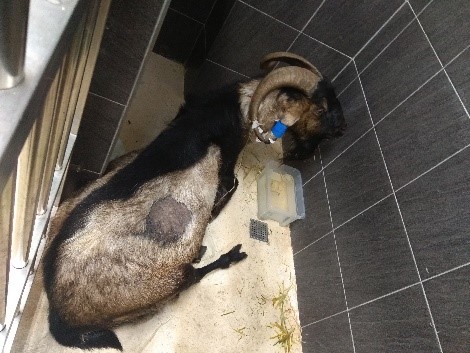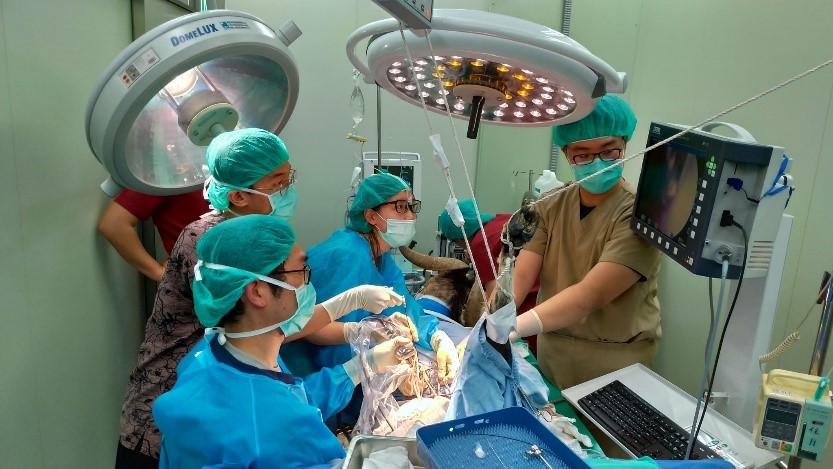
台大動物醫院協助救治山羊 展現社區關懷、教育飼養觀念
今年3月初,新北市同榮國小的一頭70公斤大公羊因無法排尿、不斷呻吟、臥地滾轉等現象,被送往臺灣大學生物資源暨農學院附設動物醫院診治。
台大動物醫院大動物科獸醫師發現該公羊因長期飼養方式不當而體態消瘦,並有脫水、腹部脹大且疼痛的情形。隨後公羊接受了X光、超音波、血液、膀胱穿刺尿液檢查等詳細檢查。經檢查發現該公羊無尿路結石,但有嚴重腹水、膀胱壁增厚、嚴重血尿、泌尿道發炎。因血液發炎指數高、腎指數超標、離子異常,有立即性生命危險,便住院給予點滴、止痛、抗生素等支持治療。隔日獸醫師緊急進行膀胱切開尿管放置術(tube cystostomy)來緩解症狀,同時進行膀胱內視鏡檢查,發現膀胱黏膜壁增厚及多處出血,於是將異常膀胱組織送病理切片分析,化驗結果為膀胱炎,無細胞癌化跡象。
.jpg)
剛就醫時的公羊,體態消瘦且出現腹部疼痛症狀。
動物醫院獸醫師指出,過去山羊病患多來自經濟農場,若因排尿困難就診,經內科治療無明顯改善,飼主多因經費成本考量而選擇安樂死。院方得知同榮國小對於支付醫療費用有困難後,考量到盡力協助同榮國小且此案例對本院實習醫生具學習價值,故協助補貼上萬元之醫療費用,院方也藉此教導校方人員正確的飼養管理方式,讓國小全體師生們了解友善對待及正確照顧動物的觀念。
而山羊出院後,已能自行排尿,復原狀況穩定良好,院方表示,此案例除了有臨床教學價值,也是本校生農學院附設單位為社會或社區付出關懷及協助的實例。
.jpg)
專業獸醫師團隊緊急為公羊做執行緩解手術,圖為手術中進行膀胱內視鏡檢查。
In early March, a 70-kilogram male goat from Tong-Rong Elementary School showed distressful groans, rolling on the ground, and no urination observed for several days. Thus, the goat was referred to the National Taiwan University Veterinary Hospital (NTUVH) for diagnosis and treatment.
After a detailed physical examination, the veterinarians of the Section of Large Animal Diseases at the NTUVH found that the goat was emaciated and dehydrated because of long-term improper diet. He also showed abdominal distension and pain. The goat underwent advanced examinations such as X-rays, ultrasound examination, and blood examination. According to X-rays and ultrasound examination, the goat had no urinary tract stones; however, severe ascites, distended bladder, and thicken bladder wall were noted. Therefore, the veterinarians then performed ultrasound-guided urine aspiration to analyze the urine in details. The collected urine was dark red. The urine analysis showed hematuria and inflammation under the microscopic examination. The blood examination showed severely elevated levels of inflammation markers, renal dysfunction, and electrolyte imbalance, which was a life-threatening situation. Therefore, supportive treatments such as intravenous fluids, analgesics, and antibiotics were provided immediately.

On the first day visiting NTUVH, the goat patient was emaciated and had abdominal pain.
After a day of aggressive treatments, the condition of the goat showed no improvement. The veterinarians thus performed surgery of “tube cystostomy,” a urinary catheterization method, to relieve the emergency condition. Cystoscopy was also performed during the cystostomy, and it revealed thickening and hemorrhages of the bladder mucosa. To further clarify the etiology of the condition, the veterinarians conducted a biopsy of bladder tissues and the specimens were sent for histopathology analysis. The result of histopathology showed cystitis, with no signs of tumors.
The veterinarians pointed out that most of their goat patients were from economic farms. In case goats with urination difficulty did not improve significantly under medical treatment, their owners usually chose euthanasia due to financial concerns. Considering the financial limits of the Elementary School and the educational value of this case for veterinary students and residents, the hospital provided assistance of a big discount to the treatment fee of over ten thousand NTD to treat the ill goat.
A month after being discharged, the goat was urinating normally, and other health conditions were stable and good. The vets of the NTUVH educated the staff of elementary school regarding proper husbandry of goats and responsibilities of being owners of the goat. The values of the case for NTUVH include responsibility and participation in community affairs by NTUVH and its educational value.

The professional veterinary team performed urgent relief surgery for the goat. The picture shows cystoscopy examination during cystostomy surgery.